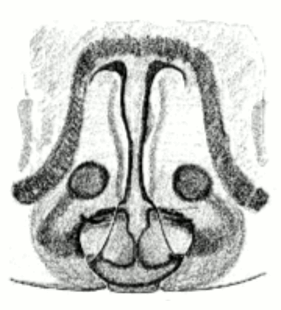Pardosa jergeniensis Ponomarev, 1979
Beschreibung
Männchen
Cymbium schwarz und mit schwarzen Setae bedeckt. Andere Palpusgelenke braun, Tegulum verlängert, Tegularapophyse groß und mit zwei gut entwickelten Armen. Embolusbasen durch eine dünne Furche zweifach unterteilt. Embolus von oben gesehen vergleichsweise dick. Terminalapophyse unterteilt in großen terminalen Teil und halb so langen subterminalen Teil. Palea mit charakteristischem Kamm. Basaler Arm der Tegularapophyse kürzer als der apikale Arm.
Körperfärbung hell. Prosomaschild 2.5 mm lang, 1.9 mm breit, dunkelbraun, Augenfeld schwarz, medianes Band gelb und mit deutlichen Rändern, seine Verbreiterung im Kopfbereich bräunlich, hellbraunes Seitenband unterbrochen. Labium und Cheliceren dunkelbraun. Sternum dunkelbraun, mit gelbem Mittelstreifen im vorderen Bereich. Gnathocoxen hellbraun.
Beine gelb und mit braunen Ringen, Bestachelung wie im Weibchen.
Dorsumzeichnung mit charakteristiscem gelben Muster in der Herzregion und mit zwei Längsbändern an den Seiten, mit einer Anzahl querausgerichteter, paariger, ovaler Flecken. Seiten schwärzlich. Venter gelb und mit grauem Mittelband, Bereich zwischen Pedicel und Epigastralfurche grau.
Körperlänge Männchen: 4.5 mmWeibchen
Epigynenseptum vergleichsweise lang und dünn, Septumbasis so breit wie die beiden Vordertaschen zusammen, basale Breiet des Septums halb so lang wie der Stamm (Stamm : Basalteil = 0.64), Fovea groß und mit characteristischen Seitenrändern, transparente Receptaculae über dem basalen Septumteil angeordnet.
Prosomaschild 3.5 mm lang, 2.8 mm breit, Mittelband breit, Seitenbänder erreichen den Kopfbereich, Kopfbereich schwarz und mit zwei Längsstreifen zwischen den HMA. Cheliceren gelb und mit braunen Streifen. Sternum dunkelbraun mit gelben Mittelstreifen im Vorderteil und mit gelben Rändern. Labium und Gnathocoxen gelb.
Beine gelb und mit braunen Ringen.
Dorsumzeichnung mit charakteristischem gelbem Muster.
Körperlänge Weibchen: 7.6 mmZusätzliche Informationen
Schwesterart von P. azerifalcata. Tegulum kürzer und Tegularkamm deutlich kleiner in P. jergeniensis.
Verbreitung
Phänologie
| Jan | Feb | Mar | Apr | May | Jun | Jul | Aug | Sep | Oct | Nov | Dec |
 |  |
Abbildungen
Verbreitungsnachweise
"No reference" bedeutet nicht, dass die Art in diesem Land nicht vorkommt, sondern dass wir die Referenz hierfür noch nicht eingefügt haben. Wir arbeiten daran.
Literatur
Marusik Y M, Guseinov E F, Koponen S (2003a) A survey of east Palaearctic Lycosidae (Araneae). I. On three closely related species of the Pardosa falcata-group. Acta Arachnologica 52: 43-50 ![]()
Mikhailov K G (2013) The spiders (Arachnida: Aranei) of Russia and adjacent countries: a non-annotated checklist. Arthropoda Selecta, Supplement 3: 1-262 ![]()
Otto S (2022) Caucasian spiders. A faunistic database on the spiders of the Caucasus Ecoregion. Database version 02.2022. Internet: caucasus-spiders.info.
Ponomarev A V (2022) Spiders (Arachnida: Araneae) of the southeast of the Russian Plain: catalogue, the fauna specific features. SSC RAS Publishers, Rostov-on-Don, 640 pp. ![]()
WSC (2025) World Spider Catalog. Version 26. Natural History Museum Bern, online at http://wsc.nmbe.ch (28.2.2025) doi: 10.24436/2 ![]()




